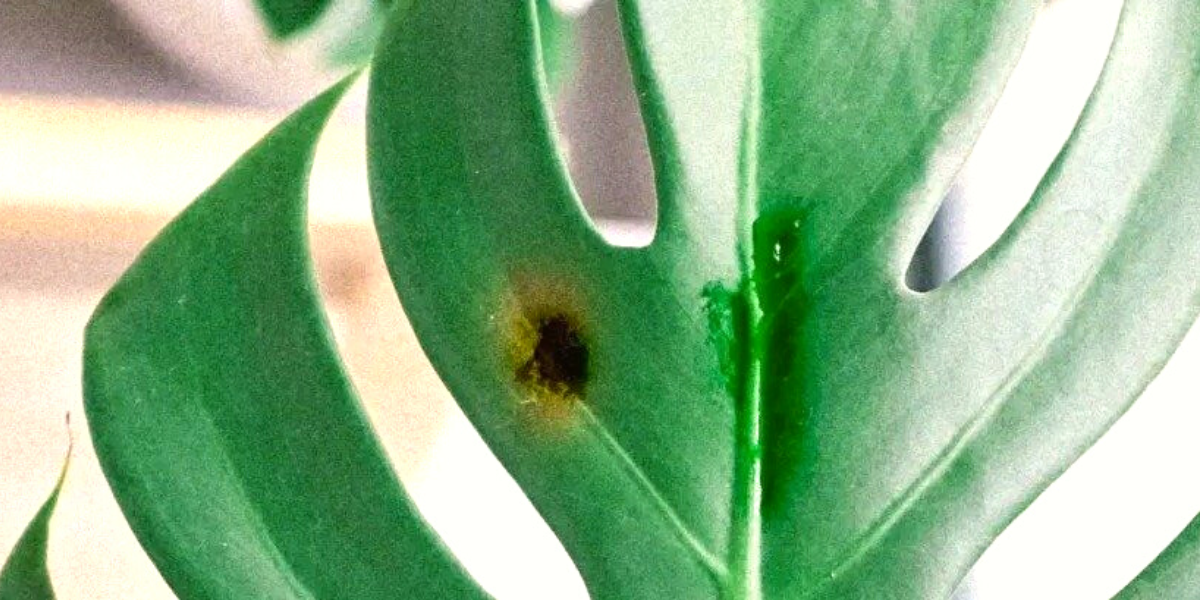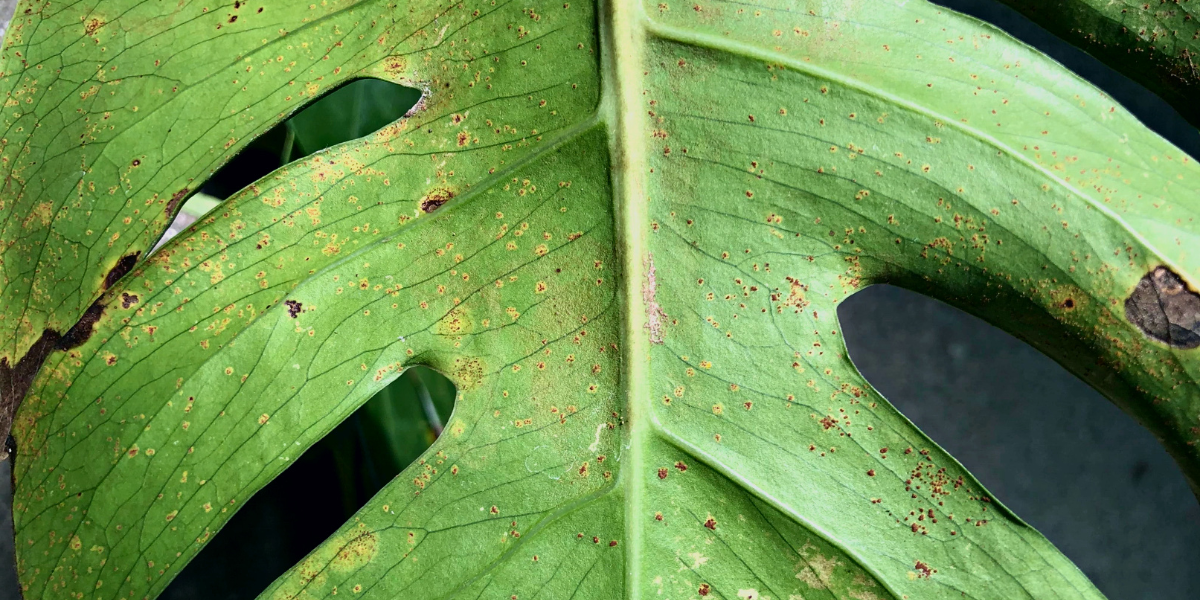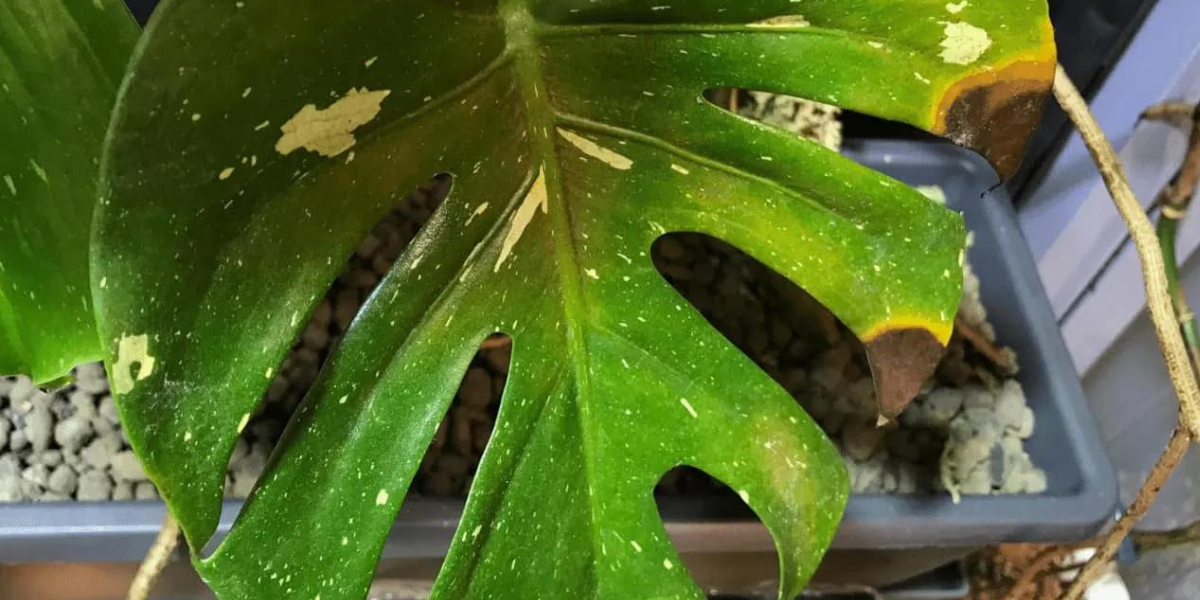Monstera is a giant vine that used to grow in rainforests and now lives in our homes. Its distinctive feature is the large, slick as if waxed, heart-shaped leaves with bizarre cutouts; each leaf is unique. Their color can be a variety of green shades. As it grows upward, it puts out long aerial roots that add to this plant’s charm. When growing a monstera, it is important to know it is poisonous and can cause itching and irritation on the skin and mucous membranes.
This houseplant is not considered particularly demanding in terms of care and maintenance. By and large, all it needs is stable heat and even lighting and watering. However, some mistakes made by novice gardeners can lead to diseases, particularly the appearance of black spots on monstera. It is what this article is about.
Black Spots on Monstera Overview
Black spots on monsteras are usually not a specific disease in and of themselves. They are only an indirect signal something is wrong with your monstera, and you need to take it more carefully. Since the main decoration of this plant is its magnificent leaves, owners quickly notice changes in color and the appearance of black spots on them.

It is important to understand what is causing black spots to get rid of it and prevent the monstera from dying. Among the most common causes are the following:
- Overwatering. The monstera is a tropical plant that really loves plenty of moisture. However, excessive watering and poor drainage can significantly impair the vine’s health and even completely destroy it.
- Root rot. It is one of the plant diseases resulting from excessive soil moisture. Root rot is a severe condition that requires specific action from the owner. In a state of neglect, heavy trimming of damaged parts may be required.
- Underwater. Insufficient watering leads to dehydration, so you, too, can find black spots on your monstera. Make sure the soil doesn’t dry out too much.
- Sunburn. In tropical forests, the light is usually diffused due to dense vegetation. That is why direct sunlight should be avoided on the monstera, as it can lead to severe burns on the leaves.
- Low humidity. If the air in the room is dry, even with sufficient watering, the monstera may not feel well. Do not forget tropical vines should not only be watered but also sprayed regularly (but not too much) or gently wiped with a damp cloth.
- Lack of nutrients. Monstera loves to be fed during the active growth season. If you don’t do it or plant it in old soil that has lost its beneficial properties, you will probably find black spots on the monstera leaves.
- Fungus and bacteria. They can appear due to excessive watering and provoke more serious diseases. Also, if you have diseased plants with black spots in your home, you can introduce the disease using the same gardening tools.
- Pests. Various insects can also move from one flower to another if they stand close enough.
- Hypothermia. Monstera, being a tropical liana, does not tolerate cold and drafts. Because of them, its health deteriorates, and it becomes susceptible to various diseases and black spots.
- Physical damage. Everything is pretty simple here. If you regularly hit the monstera, just move it to another place. Perhaps you damaged it during transportation or tried to unroll a young shoot. In any case, leave the monstera vine alone.
By the way, some growers sometimes forget plants are also subject to aging. If you find black spots on the lowest monstera leaves, it is more likely due to age and not disease. Such vines just need to be given more nutrition.
As you can see, there are many reasons for the appearance of black spots on monstera. The specific treatment depends on what exactly became the cause. Do not be upset if small dots appear on the juicy green leaves. Even damaged ones can continue to grow. They do not die off and do not lead to infection of the whole monstera. When you find the cause of the appearance of black spots and eliminate it, they will not disappear. But new leaves will grow without them.
Black Spot on Monstera Leaf Symptoms and Diagnosis
“Black spots” is not a specific term but a symptom of several potential diseases at once, and the signs that accompany it can be very different. These spots themselves can vary in size and shape and can be with well-defined edges and not, light brown and black, etc. But the rest of the set of symptoms may differ.

That is why it is essential to carefully examine the plant from all sides and determine additional indicators of any monstera diseases. Since spots can mean a wide variety of problems, it’s best to use the app to classify the problem for sure:
- Place the vine in a well-lit area. It is best to remove monstera from the pot and lightly shake the ground off. So you can assess the condition of the roots.
- Photograph the whole flower and separately all its damaged parts. Because monsteras can grow to enormous sizes (hence the name), you may need assistance to keep the plant out of the pot.
- Add all pictures to the app, and the system will analyze them. After that, it will offer you a list of several diseases with an indication of the percentage of probability. The one with the most matches will be at the top of the list.
Think of the app as a source of independent assessment and your pocket helper in determining the disease. Of course, you should also have some knowledge about monstera growing. With the help of our service, you can confirm or refute your guess.
Now let’s look at additional symptoms that may accompany the appearance of black spots on monstera:
- Excessive watering and high humidity lead to the rotting of the roots as the oxygen balance in the soil is disturbed. The ground is constantly wet and gradually becomes more compacted. If you do not arrange irrigation in time, it can lead to the appearance of root rot and the development of various fungal diseases. You will smell an unpleasant stink rising from the ground. And if you take the monstera out of the pot, the roots will be slippery to the touch and brittle.
- Hypothermia. Usually, the low temperature in the room and the drafts mean the soil in the monstera pot never dries well enough. All this leads to root system diseases and the appearance of the already mentioned root rot with a characteristic state of the plant’s lower part and an unpleasant smell. It is strictly forbidden to take out the monstera outdoors; it is exclusively an indoor plant.
- Insufficient watering and low humidity. Dry, crispy leaf edges are usually added to the black spots. Gradually, the full foliage and even the trunk acquire a yellowish tint, and the general appearance becomes rather dull. Below 40% humidity, the soil in the pot is too dry, and the roots do not have enough moisture to fill the monstera with useful elements.
- Pests. If you are attentive enough to your monstera, you will notice the appearance of insects on young shoots, undersides of leaves, and at the junction of leaves and trunk. You may also see the holes they gnaw in the monstera leaves, as well as the sticky mold some pests leave behind.
- Sunburns and physical damage are, of course, unpleasant, but they are usually not accompanied by any additional symptoms.
Ideally, monstera leaves are dense, light, or dark green with natural holes and curly cutouts. If the plant is doing well, it will regularly put out new leaves and aerial roots. The appearance of black spots clearly indicates something is wrong with your vine. It is important to notice them on time and carefully examine all parts. Look for other symptoms that will help you identify the specific disease. Even if it turns out that the change in leaf color was due to mechanical damage, it is better to rule out the possibility of something more serious. However, as statistics show, the most likely cause of dark spots on the leaves is excessive watering and too high humidity.
Treatment for Dark Spots on Monstera Leaves
Since the causes of black spots can be different, their cure methods also vary. Let’s look at the most common ones.

Overwatering
We already wrote that monstera belongs to tropical plant types, which means it loves moisture. However, too much of it is just as bad as too little. If you realize you water your bush too often quite early, that is, the root rot has not yet had time to develop; it is enough just to establish proper irrigation. Just let the soil dry out for a while. Experts recommend drying the ground to a depth of about 1/4 of the total volume during the cold months. It should not be allowed to dry deeper than 1 inch in summer. Although it will not cause irreparable harm, the complete drying of the soil can still make the monstera leaves lose their characteristic “waxy” sheen. Water should be soft and at room temperature. Make sure it does not stagnate in a pot.
Root rot
If you have been watering the monstera too often for a long time, and it has led to the rotting of the root system, more serious measures will be needed. Remove the bush from the pot, cut off the damaged roots, and disinfect them. At the same time, it is advisable to change the soil to a new one, not infected, to stop the disease cycle. Also, make sure the monstera pot has enough drainage so that the water flows freely into the tray and does not stagnate. The collected water should be drained. Of course, from now on, you need to monitor the watering carefully so that there is no relapse.
Underwater
Monstera is a fairly tolerant plant. If you forgot to water it on time once or did not maintain sufficient humidity in the room, it will survive. Compensate for this with more thorough maintenance, and don’t let the soil dry out completely. To maintain the desired humidity level, you can use a humidifier, regularly wipe the leaves with a damp cloth, or spray the monstera. The main thing is that moisture does not accumulate on the leaves.
Nutritional deficiency
Monstera loves to be fed. If you examined the plant thoroughly and did not notice signs of other black spot diseases, it can be assumed that your vine is not getting enough nutrition. monstera’s huge leaves require a lot of resources, and since they grow quickly, they also deplete the soil faster than other flowers. Choose the right fertilizer to feed weekly or biweekly during active growth. If your bush slowed down development in winter, then reduce the number of applications to 1 time per month. All this will not only help the monstera grow but also make it resistant to diseases.
Fungus and bacteria
Bacterial and fungus infestation requires more than just drying out the soil to prevent transmission of the disease to other plants. You need to remove the affected parts of the monstera and treat it with a fungicide or any other natural remedy like neem oil or DIY baking soda sprays. It is important not only to water the ground but also to sprinkle the trunk and leaves with these products to kill fungus spores, viruses, or bacteria. Provide the bush with the optimal watering regime, room temperature, and humidity level.
Pests
This cause of black spots is one of the most difficult to treat. The fact is that to determine the correct care method, you need to understand which insect has settled on your monstera. As a rule, by the unique behavior of each species, you can determine the pest and, therefore, choose the right chemical or natural treatment. Mostly, mealybugs, aphids, scales, or spider mites appear on such plants. Each requires a special approach, the use of pesticides, fertilizers, and, of course, the establishment of an irrigation regime. Since you have such insects, it means the plant has weakened for some reason, and it needs help to recover.
Timely detection of black spots on monstera and associated symptoms will allow you to understand what exactly hurts your plant and help it get better. The key to the well-being of this vine is proper watering, temperature control, sufficient humidity, diffused light, and regular fertilization. Remember it doesn’t like to move around very much, so move it from place to place in several steps and compensate for stress by increasing the humidity in the room. Your monstera will grow healthy and constantly delight you with new leaves if you follow these simple guidelines.
Leave a Reply
You must be logged in to post a comment.